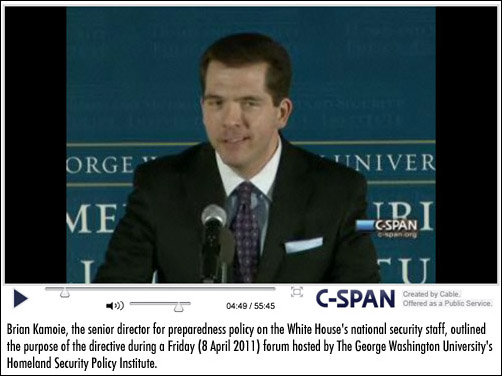 On 30 March 2011, President Barack Obama signed Presidential Policy Directive #8 (PPD-8), also known as the National Preparedness Goal. On 8 April 2011, Brian Kamoie, Senior Director for Preparedness Policy on the White House National Security Staff, held a press conference at the Homeland Security Policy Institute in Washington, D.C., to officially release and outline President Obama’s plan to strengthen the security and resiliency of the nation and its people against acts of terrorism, pandemics, significant accidents, and natural disasters.
On 30 March 2011, President Barack Obama signed Presidential Policy Directive #8 (PPD-8), also known as the National Preparedness Goal. On 8 April 2011, Brian Kamoie, Senior Director for Preparedness Policy on the White House National Security Staff, held a press conference at the Homeland Security Policy Institute in Washington, D.C., to officially release and outline President Obama’s plan to strengthen the security and resiliency of the nation and its people against acts of terrorism, pandemics, significant accidents, and natural disasters.
PPD-8 was developed in light of the Post-Katrina Emergency Management Reform Act of 2006 and replaces President George W. Bush’s 2003 Homeland Security Presidential Directive (HSPD) #8 plus 2007 HSPD Annex 1. This new directive strives to streamline and simplify the preparedness process – prevention, protection, mitigation, response, and recovery – using a multi-discipline, multi-jurisdictional design. Acknowledging successful planning efforts from FEMA (Federal Emergency Management Agency), CDC (Centers for Disease Control and Prevention), and HHS (U.S. Department of Health and Human Services), PPD-8 is based on three key principles:
Use an “All of Nation” approach – Similar to Craig Fugate’s, Administrator of FEMA, “Whole of Community” planning effort, PPD-8 stresses the importance of working together to be better prepared. Integrating efforts across all levels of government, collaborating with private and non-profit sectors, and engaging families, individuals, and communities in the preparedness process will help secure the nation against 21st-century threats. Developing a national preparedness system will help guide the necessary activities and objectives.
Build capabilities to confront any challenge – As FEMA calls the “Maximum of Maximums,” planning should be done from the perspective of the worst-case scenario. In March 2011, the CDC released “Public Health Preparedness Capabilities: National Standards for State and Local Planning.” As with the 15 capabilities outlined in the CDC report, recognizing the capabilities of each entity involved in all-hazards efforts will make those efforts more integrated and flexible for any threat, hazard, or actual event.
Implement a more rigorous assessment system – By creating specific and measurable objectives, PPD-8 focuses on outcomes by measuring and tracking progress over time. Using this principle, FEMA and HHS are in the process of evaluating grant programs to align them with the desired outcomes.
Implementing a multi-discipline, multi-jurisdictional approach to national preparedness will help the United States reach its overarching national preparedness goal. PPD-8 addresses the fact that a one-size-fits-all approach to preparedness in a nation where each community has different needs based on different risks does not work. By pooling efforts, defining capabilities, and focusing on outcomes, the nation will be better prepared for any hazard. Kamoie sums up the objective of the National Preparedness Directive: “We aim to prevent what we can and respond rapidly to what we must.”

